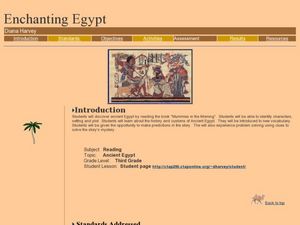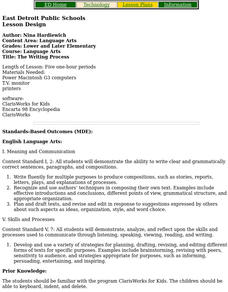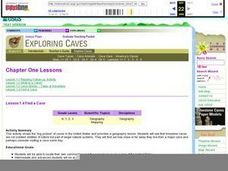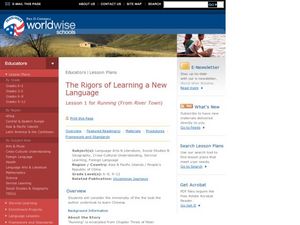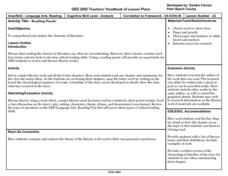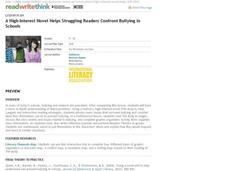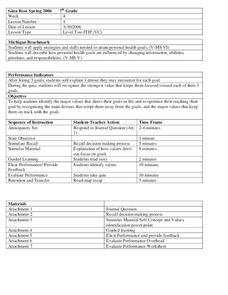Curated OER
A Book Is A Window To the World
Second graders listen to pieces of literature that take place in different regions of the world. Using a map, they identify and locate the continents and oceans mentioned in the story. They describe the physical and human characteristics...
Curated OER
Enchanting Egypt
After reading the Magic Tree House book Mummies in the Morning, learners talk about Ancient Egypt. They identify the plot, characters, setting, etc., explore vocabulary terms, and construct a pyramid. This will motivate your class...
Curated OER
The Writing Process
Show your young researchers how to find information, brainstorm a topic, map or outline their own stories, and create rough drafts. This lesson also shows learners how to peer edit, conference with the teacher, and write their final...
Curated OER
Prince Ibrahima
Sixth graders read and utilize the facts from the story "Abd al-Rahmen Ibrahima" by Walter Dean Myers to analyze the main character's life which is ruined by conflict, jealousy, and greed. Journal entries are created in response to the...
Curated OER
Find a Cave
Students locate their own communites and the nearest caves on a United States map. They calculate the distance to the nearest cave using rough scale.
Curated OER
The Talking Goat
Young scholars read and analyze an African folktale. They read and discuss the folktale, analyze a map of Africa and Liberia, complete a worksheet, answer discussion questions, and analyze the patterns and analogies of the folktale.
Curated OER
The Rigors of Learning a New Language
Students examine the experiences of a Peace Corps volunteer learning to speak Chinese. They read and discuss an essay written by the Peace Corps volunteer, analyze a map of China, and discuss the author's difficulties in learning the...
Curated OER
Immigration Connections: The Squamish Nation and Bainbridge Island Filipino Americans
High schoolers explore ancestry and immigration. In this Canadian immigration lesson, students interview their family members to identify their cultural history. They compose an essay that compares Filipino immigration stories to those...
Curated OER
Reading Puzzle
Twelfth graders examine the elements of literature. They each read a chapter of a novel, sequentially list the main ideas, present a summary of the chapter to the class, sequence the events, and review the novel by summarizing the timeline.
Curated OER
Get your Snow People Here
Students recall information from the story Snowballs to complete a story map. They also compare and contrast two Snow People and cooperatively create an original snow person.
Curated OER
A Picture Is Worth a Thousand Words
Students, after reading the book, "Esperanza Rising," create a virtual display by combining different story elements into a visual representation. They choose the setting and characters of a scene that will act as a springboard of ideas...
Curated OER
Cloudy with A Chance of Meatballs
Second graders read the book Cloudy with a Chance of Meatballs. In this Cloudy with a Chance of Meatballs lesson, 2nd graders are given a list of words from the story to write with. Students write their own story with the words, then the...
Curated OER
Johnny Appleseed or John Chapman: Which Character is Your Favorite?
Students study the life of John Chapman and compare it with the fictional character, Johnny Appleseed. Students listen to books about Johnny Appleseed, and watch a video and PowerPoint if available. They make a KWL chart, make an online...
Curated OER
That Sums It All Up!
Students review the concept of silent reading. They listen to a story and create a story map of what they hear. Then, they read their own story and map it the same way. This time, they use this story map to write a summary of what they...
Curated OER
Sentences And Sequencing
Young scholars practice writing complete sentences and sequencing three or more events. They listen to at least one version of the story read aloud and work cooperatively to put the story events in proper sequence. They...
Curated OER
The Greatest Survival Story of All Time
Learners use the Internet to read about an explorer's survival in the Antarctic. They try to find a better route for him to have taken.
Curated OER
Read a Transportation Story
Third graders research the building of a transcontinental road. In this railroad history lesson, 3rd graders discuss past and present transportation. Students look at historical photos and compare and contrast photos from today.
Curated OER
Cinderella Stories
Students listen to the Scottish tale, The Princess and the Golden Shoes, creating a character chart. They develop a newspaper containing news stories, personality profiles, and editorials regarding The Princess and the Golden Shoes.
Curated OER
Do the Tallywalker
Students study the basics of mapmaking, then make a tally walker, (geographic location device used in secret).
Curated OER
Shoes and the Backyard Landscape
Your shoes get a lot of mileage in familiar places. Represent the places you have traveled the most with an art project based on a print of Indian People Wear Shoes and Socks by Juane Quick-to-See Smith. Kids trace their shoes and...
ReadWriteThink
A High-Interest Novel Helps Struggling Readers Confront Bullying in Schools
Paul Langan's novel The Bully is the core text in a six-session unit plan that engages high schoolers in an in-depth examination of bullying and its effects on bullies, victims, and bystanders. The richly textured and carefully...
Curated OER
No Title
Seventh graders practice applying strategies and skills needed to attain personal health goals, including changing health issues, abilities, priorities and responsibilities. They explain, after listing three goals, one detour they might...
Curated OER
History of World Religions
First graders listen to a variety of Noah's Ark, based on the story in the Old Testament. They hear another "flood story" for comparison.
Curated OER
The Study of the Spanish-Speaking People of Texas: Understanding Primary Sources
Students analyze Russell Lee's photo essay as a sign of segregation in Texas. They consider the differences between primary and secondary sources and how historians use these sources.

